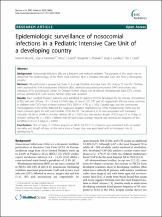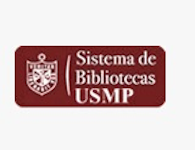| dc.contributor.author | Becerra, María R. | |
| dc.contributor.author | Tantaleán, José A. | |
| dc.contributor.author | Suárez, Víctor J. | |
| dc.contributor.author | Alvarado, Margarita C. | |
| dc.contributor.author | Candela, Jorge L. | |
| dc.contributor.author | Urcia, Flor C. | |
| dc.date.accessioned | 2020-07-17T15:53:08Z | |
| dc.date.available | 2020-07-17T15:53:08Z | |
| dc.date.issued | 2010-09-10 | |
| dc.identifier.citation | Becerra MR., Tantaleán JA., Suárez VJ., Alvarado MC., Candela JL., Urcia FC. Epidemiologic surveillance of nosocomial infections in a Pediatric Intensive Care Unit of a developing country. BMC Pediatr. 2010; 10: 66. | es_PE |
| dc.identifier.uri | https://hdl.handle.net/20.500.12727/6356 | |
| dc.description.abstract | Background: Nosocomial Infections (NI) are a frequent and relevant problem. The purpose of this study was to determine the epidemiology of the three most common NI in a Pediatric Intensive Care Unit from a developing country.
Methods: We performed a prospective study in a single Pediatric Intensive Care Unit during 12 months. Children were assessed for 3 NI: bloodstream infections (BSI), ventilator-associated pneumonia (VAP) and urinary tract infections (UTI), according to Center for Disease Control criteria. Use of devices (endotracheal tube [ETT], central venous catheter [CVC] and urinary catheter [UC]) was recorded.
Results: Four hundred fourteen patients were admitted; 81 patients (19.5%) developed 85 NIs. Density of incidence of BSI, VAP and UTI was 18.1, 7.9 and 5.1/1000 days of use of CVC, ETT and UC respectively. BSI was more common in children with CVCs than in those without CVCs (20% vs. 4.7%, p < 0.05). Candida spp. was the commonest microorganism in BSI (41%), followed by Coagulase-negative Staphylococcus (17%). Pseudomonas (52%) was the most common germ for VAP and Candida (71%) for UTI. The presence of NI was associated with increased mortality (38.2% vs. 20.4% in children without NI; p < 0.001) and the median length of ICU stay (23 vs. 6 days in children without NI; p < 0.001). Children with NI had longer average hospital stay previous to diagnosis of this condition (12.3 vs. 6 days; p < 0.001).
Conclusions: One of every 5 children acquires an NI in the PICU. Its presence was associated with increased mortality and length of stay. At the same time a longer stay was associated with an increased risk of developing NI. | es_PE |
| dc.description.sponsorship | Instituto Nacional de Salud del Niño and the Instituto Nacional de Salud of Lima, Peru. | es_PE |
| dc.format.extent | 9 p. | es_PE |
| dc.language.iso | eng | es_PE |
| dc.publisher | BMC | es_PE |
| dc.relation.ispartof | urn:issn:1472-6874 | |
| dc.relation.ispartofseries | BMC Pediatrics;vol. 2010, no. 66 | |
| dc.relation.uri | https://doi.org/10.1186/1471-2431-10-66 | es_PE |
| dc.rights | info:eu-repo/semantics/openAccess | es_PE |
| dc.rights.uri | https://creativecommons.org/licenses/by/4.0/ | es_PE |
| dc.source | Repositorio Académico USMP | es_PE |
| dc.source | Universidad San Martín de Porres - USMP | es_PE |
| dc.subject | Unidades de cuidados intensivos | es_PE |
| dc.subject | Infección | es_PE |
| dc.subject | Sistema urinario | es_PE |
| dc.subject | Infección hospitalaria | es_PE |
| dc.title | Epidemiologic surveillance of nosocomial infections in a Pediatric Intensive Care Unit of a developing country | |
| dc.type | info:eu-repo/semantics/article | es_PE |
| thesis.degree.name | Medicina Humana | es_PE |
| thesis.degree.grantor | Universidad de San Martín de Porres. Facultad de Medicina Humana | es_PE |
| thesis.degree.discipline | Medicina | es_PE |
| dc.subject.ocde | https://purl.org/pe-repo/ocde/ford#3.02.00 | es_PE |








